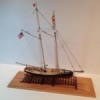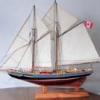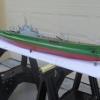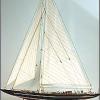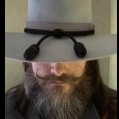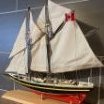MORE HANDBOOKS ARE ON THEIR WAY! We will let you know when they get here.
×
-
Posts
818 -
Joined
-
Last visited
Reputation Activity
-
 _SalD_ got a reaction from canoe21 in US Brig Syren by _SalD_ – FINISHED - 3/16" scale
_SalD_ got a reaction from canoe21 in US Brig Syren by _SalD_ – FINISHED - 3/16" scale
Continuing on with chapter 9, I decided to take another page out of Dirk’s playbook by lining my scuppers with some copper tubing. Using some 1/16” diameter tubing, one end was reamed out and then cut into 3/32” long pieces. These pieces were blackened and inserted into the holes drilled in the outboard planking and inboard waterway.
Next I started working on the aft gun and forward bridle port lids. I decided to make the lids using two plies of wood instead of the one as shown in the instructions. The outboard side of the lid was made from 1/16” x 1/8” wide strips and the inboard side was made using 1/32” x 5/32” wide strips. The two plies were run 90 degrees to each other and the inboard strips were sanded down to create the rabbet around the door. For the lid's inboard and outboard handles I tried my hand at making some small split rings that were attached to the provided eyebolts. The split rings were made by first winding some 28 gauge brass wire around the shank of a 1mm diameter drill bit. Little sections of the coil were then cut off to form the rings. After placing the rings on the eyebolts the ends were flatten to close the ring. These pieces along with the photo-etched hinges were blackened. After staining and painting the lids the handles were added and then glued into their appropriate gun port. The hinges were added last to finish the lids. It wasn’t until I was attaching the bridle port hinges that I noticed that they were not as long as shown in the manual. At that point I decided to use what was provided although I noticed afterwards that I could have easily made longer ones by using some of the excess material that’s on the photo-etched sheet.
The sixteen remaining lower gun port lids were built similar to the aft lid except for the half circle cutout. The circular cutout was done by using an 1/8” diameter, 240 grit, sanding drum on my dremel and then cleaned up with a circular needle file. They were stained and painted and the inboard handles added. I still need to add the hinges before installing these lids.
-
 _SalD_ got a reaction from Piet in Syren by JesseLee - FINISHED - Model Shipways - scale: 1:64
_SalD_ got a reaction from Piet in Syren by JesseLee - FINISHED - Model Shipways - scale: 1:64
Nice job Jesse, glad it worked out for you.
-
 _SalD_ reacted to augie in Syren by JesseLee - FINISHED - Model Shipways - scale: 1:64
_SalD_ reacted to augie in Syren by JesseLee - FINISHED - Model Shipways - scale: 1:64
Whew! Congrats. You don't want to build a banana.
-
 _SalD_ got a reaction from jdbradford in US Brig Syren by _SalD_ – FINISHED - 3/16" scale
_SalD_ got a reaction from jdbradford in US Brig Syren by _SalD_ – FINISHED - 3/16" scale
Continuing on with chapter 9, I decided to take another page out of Dirk’s playbook by lining my scuppers with some copper tubing. Using some 1/16” diameter tubing, one end was reamed out and then cut into 3/32” long pieces. These pieces were blackened and inserted into the holes drilled in the outboard planking and inboard waterway.
Next I started working on the aft gun and forward bridle port lids. I decided to make the lids using two plies of wood instead of the one as shown in the instructions. The outboard side of the lid was made from 1/16” x 1/8” wide strips and the inboard side was made using 1/32” x 5/32” wide strips. The two plies were run 90 degrees to each other and the inboard strips were sanded down to create the rabbet around the door. For the lid's inboard and outboard handles I tried my hand at making some small split rings that were attached to the provided eyebolts. The split rings were made by first winding some 28 gauge brass wire around the shank of a 1mm diameter drill bit. Little sections of the coil were then cut off to form the rings. After placing the rings on the eyebolts the ends were flatten to close the ring. These pieces along with the photo-etched hinges were blackened. After staining and painting the lids the handles were added and then glued into their appropriate gun port. The hinges were added last to finish the lids. It wasn’t until I was attaching the bridle port hinges that I noticed that they were not as long as shown in the manual. At that point I decided to use what was provided although I noticed afterwards that I could have easily made longer ones by using some of the excess material that’s on the photo-etched sheet.
The sixteen remaining lower gun port lids were built similar to the aft lid except for the half circle cutout. The circular cutout was done by using an 1/8” diameter, 240 grit, sanding drum on my dremel and then cleaned up with a circular needle file. They were stained and painted and the inboard handles added. I still need to add the hinges before installing these lids.
-
 _SalD_ got a reaction from JesseLee in Syren by JesseLee - FINISHED - Model Shipways - scale: 1:64
_SalD_ got a reaction from JesseLee in Syren by JesseLee - FINISHED - Model Shipways - scale: 1:64
Nice job Jesse, glad it worked out for you.
-
 _SalD_ reacted to JesseLee in Syren by JesseLee - FINISHED - Model Shipways - scale: 1:64
_SalD_ reacted to JesseLee in Syren by JesseLee - FINISHED - Model Shipways - scale: 1:64
Ok! Well, it worked! (mostly). There was only a very, very slight warp left. I cut thin slits in the spacer blocks in the middle where the slight bend still was. Scraped & shoved glue into these slits as best as I could & clamped them. ( those bulkheads are not warped as it looks in the pic- the camera angle makes it appear that way) This made it all straight! I did have to remove the keel strip & re-glue it on straighter & all is well. I can now move on to the gun port framing.
-
 _SalD_ got a reaction from JesseLee in US Brig Syren by _SalD_ – FINISHED - 3/16" scale
_SalD_ got a reaction from JesseLee in US Brig Syren by _SalD_ – FINISHED - 3/16" scale
Continuing on with chapter 9, I decided to take another page out of Dirk’s playbook by lining my scuppers with some copper tubing. Using some 1/16” diameter tubing, one end was reamed out and then cut into 3/32” long pieces. These pieces were blackened and inserted into the holes drilled in the outboard planking and inboard waterway.
Next I started working on the aft gun and forward bridle port lids. I decided to make the lids using two plies of wood instead of the one as shown in the instructions. The outboard side of the lid was made from 1/16” x 1/8” wide strips and the inboard side was made using 1/32” x 5/32” wide strips. The two plies were run 90 degrees to each other and the inboard strips were sanded down to create the rabbet around the door. For the lid's inboard and outboard handles I tried my hand at making some small split rings that were attached to the provided eyebolts. The split rings were made by first winding some 28 gauge brass wire around the shank of a 1mm diameter drill bit. Little sections of the coil were then cut off to form the rings. After placing the rings on the eyebolts the ends were flatten to close the ring. These pieces along with the photo-etched hinges were blackened. After staining and painting the lids the handles were added and then glued into their appropriate gun port. The hinges were added last to finish the lids. It wasn’t until I was attaching the bridle port hinges that I noticed that they were not as long as shown in the manual. At that point I decided to use what was provided although I noticed afterwards that I could have easily made longer ones by using some of the excess material that’s on the photo-etched sheet.
The sixteen remaining lower gun port lids were built similar to the aft lid except for the half circle cutout. The circular cutout was done by using an 1/8” diameter, 240 grit, sanding drum on my dremel and then cleaned up with a circular needle file. They were stained and painted and the inboard handles added. I still need to add the hinges before installing these lids.
-
 _SalD_ got a reaction from PaddyO in US Brig Syren by _SalD_ – FINISHED - 3/16" scale
_SalD_ got a reaction from PaddyO in US Brig Syren by _SalD_ – FINISHED - 3/16" scale
Prior to starting my planking I read “Planking the Built-Up Ship Model” by Jim Roberts , “Simple Hull Planking Techniques for Beginners” by Dirk DeBakker and Greg Brooker, and studied many building logs here on MSW. All these references were very informative, however, and I know this might be a little over kill but for me personally, having more of a visual type learning style, I decided to draw up, as Chuck calls it, a ‘planking-plan-of-attack’.
I started by measuring the gap along each bulkhead between the planking by using a tick strip. Next I measured the length remaining to be planked along the curve of the bow and the total distance along the stern and counter and finally the distance between each bulkhead. With these measurements I drew vertical lines representing the centerline of each bulkhead at their measured length and spacing. The dimension at the mid-ship bulkhead was 2 7/8”, which would require 23 planks @ 1/8” wide to cover the area. I used this number to divide the length of all the other bulkheads to determine the width that the plank should be at each bulkhead. Using these dimensions I drew up a plank pattern for the port and starboard sides.
To test this planking shape I made a few copies of the pattern, cut them out and pinned them to the hull. They appeared to fit well and had no puckers (clinkers). I will use this shape for planking the bow. For the stern I will either need wider (5/32”) planks or use steelers.
My thoughts are that I would use this pattern for about 7 or 8 planks and then re-adjust if need be to account for creep or ,heaven forbid, I don’t shape every plank perfectly.
-
 _SalD_ got a reaction from GuntherMT in US Brig Syren by _SalD_ – FINISHED - 3/16" scale
_SalD_ got a reaction from GuntherMT in US Brig Syren by _SalD_ – FINISHED - 3/16" scale
Continuing on with chapter 9, I decided to take another page out of Dirk’s playbook by lining my scuppers with some copper tubing. Using some 1/16” diameter tubing, one end was reamed out and then cut into 3/32” long pieces. These pieces were blackened and inserted into the holes drilled in the outboard planking and inboard waterway.
Next I started working on the aft gun and forward bridle port lids. I decided to make the lids using two plies of wood instead of the one as shown in the instructions. The outboard side of the lid was made from 1/16” x 1/8” wide strips and the inboard side was made using 1/32” x 5/32” wide strips. The two plies were run 90 degrees to each other and the inboard strips were sanded down to create the rabbet around the door. For the lid's inboard and outboard handles I tried my hand at making some small split rings that were attached to the provided eyebolts. The split rings were made by first winding some 28 gauge brass wire around the shank of a 1mm diameter drill bit. Little sections of the coil were then cut off to form the rings. After placing the rings on the eyebolts the ends were flatten to close the ring. These pieces along with the photo-etched hinges were blackened. After staining and painting the lids the handles were added and then glued into their appropriate gun port. The hinges were added last to finish the lids. It wasn’t until I was attaching the bridle port hinges that I noticed that they were not as long as shown in the manual. At that point I decided to use what was provided although I noticed afterwards that I could have easily made longer ones by using some of the excess material that’s on the photo-etched sheet.
The sixteen remaining lower gun port lids were built similar to the aft lid except for the half circle cutout. The circular cutout was done by using an 1/8” diameter, 240 grit, sanding drum on my dremel and then cleaned up with a circular needle file. They were stained and painted and the inboard handles added. I still need to add the hinges before installing these lids.
-
 _SalD_ got a reaction from rtropp in US Brig Syren by _SalD_ – FINISHED - 3/16" scale
_SalD_ got a reaction from rtropp in US Brig Syren by _SalD_ – FINISHED - 3/16" scale
Continuing on with chapter 9, I decided to take another page out of Dirk’s playbook by lining my scuppers with some copper tubing. Using some 1/16” diameter tubing, one end was reamed out and then cut into 3/32” long pieces. These pieces were blackened and inserted into the holes drilled in the outboard planking and inboard waterway.
Next I started working on the aft gun and forward bridle port lids. I decided to make the lids using two plies of wood instead of the one as shown in the instructions. The outboard side of the lid was made from 1/16” x 1/8” wide strips and the inboard side was made using 1/32” x 5/32” wide strips. The two plies were run 90 degrees to each other and the inboard strips were sanded down to create the rabbet around the door. For the lid's inboard and outboard handles I tried my hand at making some small split rings that were attached to the provided eyebolts. The split rings were made by first winding some 28 gauge brass wire around the shank of a 1mm diameter drill bit. Little sections of the coil were then cut off to form the rings. After placing the rings on the eyebolts the ends were flatten to close the ring. These pieces along with the photo-etched hinges were blackened. After staining and painting the lids the handles were added and then glued into their appropriate gun port. The hinges were added last to finish the lids. It wasn’t until I was attaching the bridle port hinges that I noticed that they were not as long as shown in the manual. At that point I decided to use what was provided although I noticed afterwards that I could have easily made longer ones by using some of the excess material that’s on the photo-etched sheet.
The sixteen remaining lower gun port lids were built similar to the aft lid except for the half circle cutout. The circular cutout was done by using an 1/8” diameter, 240 grit, sanding drum on my dremel and then cleaned up with a circular needle file. They were stained and painted and the inboard handles added. I still need to add the hinges before installing these lids.
-
 _SalD_ got a reaction from Jimz66 in US Brig Syren by _SalD_ – FINISHED - 3/16" scale
_SalD_ got a reaction from Jimz66 in US Brig Syren by _SalD_ – FINISHED - 3/16" scale
George, Augie, Thomas and wq3296 thanks for looking in and the kind words.
Augie thanks for checking on the rudder material from Jim.
wq3296 thanks for the info. I believe the ship builders knew of the adverse reaction between iron and copper in salt water. I would think that if they did use iron fittings on the coppered hull they would probably need to provide some sort of separation between the fitting and copper. I'm not sure about bronze in a salt solution need to do a little more reading.
-
 _SalD_ reacted to popeye the sailor in Andrea Gail by popeye the Sailor - FINISHED - 1:20 scale
_SalD_ reacted to popeye the sailor in Andrea Gail by popeye the Sailor - FINISHED - 1:20 scale
here are a couple pictures of the build overall.
-
 _SalD_ reacted to popeye the sailor in Andrea Gail by popeye the Sailor - FINISHED - 1:20 scale
_SalD_ reacted to popeye the sailor in Andrea Gail by popeye the Sailor - FINISHED - 1:20 scale
not much Patrick.......as mentioned, I was saving this for the last step. the reason is that with them on the deck, they actually gave me the feeling that it was finished......I've already done a dry fit, plotting which ones to show together and where. so....I held off on showing any pictures of them on the deck.......even kept them out of sight, so they would be forgotten. it worked well.......no one has mentioned anything about them
I'm talking about the fuel drums. I was thinking about the rack......I wanted to put a few there, so I drilled a couple holes and made up a couple of those small hooks. after painting them white, allowing them to dry a bit, the small copper chain was used to lash them in place {cemented in place as well, of course}.
OK........that was enough for me.........the bow was set up. after deciding which ones to pair up, these too were cemented in place and lashed. a little forethought here would have been nice......perhaps soldering some eyes to the railings or something, but since I didn't do that, I decided on a simpler approach. the chain was tied to the railing with white thread, and the excess was wrapped around the railing........works just as well in my book I started with the starboard side, and then moved to the port side after.
now, on the port side, you see two further back on the fore deck........I changed that. there were going to be too many on the port side.........may make her list, so I moved the extra to the other side.
so now, other than adding some rope coils and a few bobbles, all that need to be done, are the life preservers, and what I call the floatation boundary lines. they are in the kit, so I will add them. something I want to add to these lines {I may make two of them}, is something I believe 'probablynot' asked in his Bluenose thread.......a thing called 'baggywinkles' . don't quote me....I haven't even looked into his thread, if his is the actual thread.....but I'll be checking this out. I'll be simply tying short pieces of thread to the line and combing the ends out so they become loose and hairy.
I'd do this now.......but I have to wait till I get paid before I can go off on the scavenger hunt to buy the size beads I'll need. I do still have those beads that I like to make the small floatation buoys....like the ones I made for the Nordkap, the Cux 87, and the Mary Ann. but, I voted it down, since these should be a round float, rather than oval thingies. I thought I had some already made still, but I must have used them all.
-
 _SalD_ reacted to AON in How much detail is too much
_SalD_ reacted to AON in How much detail is too much
Every time I start a piece I say a small pray for guidance from above: Please Lord tell me "when"
-
 _SalD_ reacted to Robert-J-M in US Brig Syren by Robert-J-M - Model Shipways - 1:64 - 18 gun brig
_SalD_ reacted to Robert-J-M in US Brig Syren by Robert-J-M - Model Shipways - 1:64 - 18 gun brig
Faired the topsides using the sheets the bulkheads came out of. Once the bulkheads are removed, there are no markings on the sheets to know which one came out which hole so I emailed Model Shipways for a photo or drawing of sheets B & C. The reply was to use the drawings provided with the kit to match them up, oh well, just took a little longer. It took a few tries but finally I cut them right at the turn of the bilge so they would fit. It did help a bit getting that concave shape in the outboard topsides. I mostly used a 3" diameter paper roll center to fair the bulwarks.
I decided to use single pieces of balsa to form the counter. I find it hard to know exactly how this should be shaped but I figure once I get to stern planking done and start the hull planking I'll get a better feel.
Painting the gunport now and then on to planking the bulwarks, doing allot of reading first though.
Robert
-
 _SalD_ reacted to JesseLee in Syren by JesseLee - FINISHED - Model Shipways - scale: 1:64
_SalD_ reacted to JesseLee in Syren by JesseLee - FINISHED - Model Shipways - scale: 1:64
Well, getting very frustrated with the computer. I wont put the pics in the correct order for some reason but you can figure it out.
Same bulwark broke again so I pinned it with a toothpick. Got the filler blocks all cut out & dry fitted.
-
 _SalD_ reacted to Laxet in US Brig Niagara by Laxet - FINISHED - Model Shipways
_SalD_ reacted to Laxet in US Brig Niagara by Laxet - FINISHED - Model Shipways
Well, this is it. As far as I'm concerned, she is done. Here are some more final pics. It's been fun. I'll be monitoring this forum in case anybody wants to discuss anything.
-
 _SalD_ reacted to Timmo in Cruizer-class brig by Timmo - FINISHED - 1:36 scale - RADIO
_SalD_ reacted to Timmo in Cruizer-class brig by Timmo - FINISHED - 1:36 scale - RADIO
First of the planking on with the lower counter and wing transom planked.
Rather than bending them laterally straight planks were used on the counter with shaped planks at top and bottom.
Finished counter. There's a small lip of about .8mm att the top of the transom (bottom in the pic) from the thicker planks that will allow a decorative moulding to sit along the edge later on.
A slot was cut for the stern post, which is unfixed still. The rudder hole will be cut later. The port filler blok was a bit short so has been replaced with another yet to be shaped.
Wales are next. Petrejus says three strakes for the wales but the plans show two in anchor stock pattern.
Helpfully, in the appendices is a reprint of the builder's contract for the brig Raven of 1804. This details two main stakes of 4 1/2 inches with a single stake of thick stuff of 3 1/2 inches above these and below with the lower thinned into the rest of the planking.
I'll try this when I get a moment in the shipyard.
-
 _SalD_ reacted to popeye the sailor in Andrea Gail by popeye the Sailor - FINISHED - 1:20 scale
_SalD_ reacted to popeye the sailor in Andrea Gail by popeye the Sailor - FINISHED - 1:20 scale
thanks to everyone......this has been such a positive project, and you have been wonderful folks to share it with. I had my doubts with adding another build to my roster, but when I look over at my table, and read all your comments, this tangent that I went on has been worthwhile. one more day at work and then I can get back to the table. sincere comment......sure.......but it's one way to show how much I appreciate all you folks following along
-
 _SalD_ reacted to Timmo in Cruizer-class brig by Timmo - FINISHED - 1:36 scale - RADIO
_SalD_ reacted to Timmo in Cruizer-class brig by Timmo - FINISHED - 1:36 scale - RADIO
The deadwood was cut from ply and designed to interlock with and to square up the aft-most frames. Here you can also see the frame positions drawn on the building board as per the frame location lines on the plans and support blocks to help square up the frames.
The deadwood was sanded down with a beard line to take account of the planking width to come and the keel had also been given a rabbet with a combination of files, dremel and table saw earlier.
The wing transom looks simple but has both a camber across the top and laterally. This was cut from ply and sander in. A slot in the deadwood holds it in and the stern post will lock it into position later.
The aftmost frame had slots for the stern supports cut in and the supports added. Like many brigs The cruizer had distinctive chase ports and the supports frame these on one side to help with positioning.
The stern was cut from 2mm ply and bent to shape before being epoxied into place.
Filler blocks of balsa have been added at the bow and stern and are being shaped as the frames are being sanded in preparation for planking. The stern post is visible in the foreground of the stern pic. It'll be installed when the planking is finished.
-
 _SalD_ reacted to Timmo in Cruizer-class brig by Timmo - FINISHED - 1:36 scale - RADIO
_SalD_ reacted to Timmo in Cruizer-class brig by Timmo - FINISHED - 1:36 scale - RADIO
After a month of work on my new project it's at the stage where I suspect it might turn into something worth continuing so here it is...
A Cruizer class brig in 1:36 scale which is (hopefully) destined to be a working RC square rigged sailer.
I've kicked this project off before finishing the rigging on my current Granado build after seeing a few build logs and being filled with inspiration and a reckless confidence to simply have a go. It's a good vessel to practice on as it's relatively simple with flush decks, only two masts and little decoration. I can experiment with the rc servos, ballast keel and sail operation once the hull and masts are done and if it works then move on to the nice to have items like head rails, carronades and deck fittings.
The cruizer was a possibility for my next scratch build originally planned at 1/64 but I'd helped my father build the 1:20 scale Valdivia schooner kit from Robbe a few years back and being so taken with sailing it that I wanted one of my own.
I'd love a 1:24 scale RC Surprise or cruizer from Steel Chapman and Hutchinson Ltd http://www.modelsailingships.com/ships/grasshopper.html
But it's out of my price range once freight etc is taken into account, hence an effort to scratch build, especially after seeing the very informative logs from Jerry Todd for his Macedonian, Constitution and others.
1:36 was chosen as it's large enough to look the part and have some sailing ability and be easily managed with a length of 84cm on the gun deck.
If successful with the brig the ultimate goal is a frigate and at 1:36 scale a large vessel like an Artois class frigate of 146 feet on the gun deck would be just manageable for transport and launch at roughly 120cm. But that's pretty optimistic at this stage and I've got a lot to learn yet.
The plans for this vessel are those included in EW Petrejus' fine book 'modelling the brig of war Irene' scaled up with bulkhead widths and deadwood for building purposes etc drawn in.
Using relatively cheap materials was a must for this project as there's still an element of doubt over if it will work. If it doesn't I don't want to feel like it's been a huge investment that fails.
As such the brig will be built from 9mm plywood for the framing with the keel and planking from matai - a New Zealand native timber which is moderately hard enough to hold detail at this scale while still easy to work and has a nice tone although the brig will be painted anyway.
The matai is in the form of old tongue and groove floorboards from a demolition yard that are going for about $6/metre for short lengths that are pretty much unusable for anything else. I can mill these on my table saw and with a home built thickness sander.
The hull will be built upside down on a building board for stability and will be cut loose once planked. A base line parallel to the keel a few cms above the max height of the sheer line was drawn on the plans to provide a point from which to measure from. All the bulkheads were drawn with this line as a top (or bottom once upside down on the board) square edge to ensure they would all sit at the correct height from the board and provide a level run for the keel to attach to.
A test run of bulkheads on the board.
To avoid installing deck beams later these were drawn onto the bulkheads using the camber indicated in Petrejus. The bulkheads were then cut down to ribbing size. In hindsight I should have left the bulwarks above deck ticker to account for the reduction from subsequent sanding but it's nothing major.
Most of the framing on the build board here. The keel and stem is matai ripped on a bandsaw and run through my drill powere thickness sander (thanks to MSW member Snowmans for his fine instructions on making one) down to 9mm. The stem was then cut in one piece on the bandsaw and gammoning and bob stay holes/slots drilled.
-
 _SalD_ reacted to dafi in HMS Victory by dafi - Heller - PLASTIC - To Victory and beyond ...
_SalD_ reacted to dafi in HMS Victory by dafi - Heller - PLASTIC - To Victory and beyond ...
And then the assembly, taking measure by putting the lid on the barrel, marking the positions with a needle ...
... drilling and fitting test.
Still missing the lanyards . Took my drilled and streched sprue ...
... a template gives the right distances ...
... open the holes with drills step by step ...
... introduced the tubes ...
... still spliced the lanyards to the rings and introduced them into the tubes ...
... and with some luck ...
... one gets ...
... something like that.
XXXDAn -
 _SalD_ reacted to mtaylor in Syren by JesseLee - FINISHED - Model Shipways - scale: 1:64
_SalD_ reacted to mtaylor in Syren by JesseLee - FINISHED - Model Shipways - scale: 1:64
Jesse,
You're off to a good start. Those frame pieces are delicate and I don't think you'll find a modeler anywhere who hasn't broken some off. Now if they made the bulkheads from cast iron... they might not break.
-
 _SalD_ reacted to GLakie in Syren by JesseLee - FINISHED - Model Shipways - scale: 1:64
_SalD_ reacted to GLakie in Syren by JesseLee - FINISHED - Model Shipways - scale: 1:64
As enthusiastic as we all might seem Jesse, nobody's in a hurry here. Whatever speed you feel good with, will be great until you're feeling better. Take your time and have fun!
Cheers
-
 _SalD_ reacted to JesseLee in Syren by JesseLee - FINISHED - Model Shipways - scale: 1:64
_SalD_ reacted to JesseLee in Syren by JesseLee - FINISHED - Model Shipways - scale: 1:64
Cut the bulkheads out to start the dry fitting & tapering the angles on the sides. Barely got started & I can tell I'm losing my touch. This stupid disease makes anything manual difficult for me & I already broke my first bulkhead. Drilled a hole through each piece & glued a toothpick through it with wood glue.


